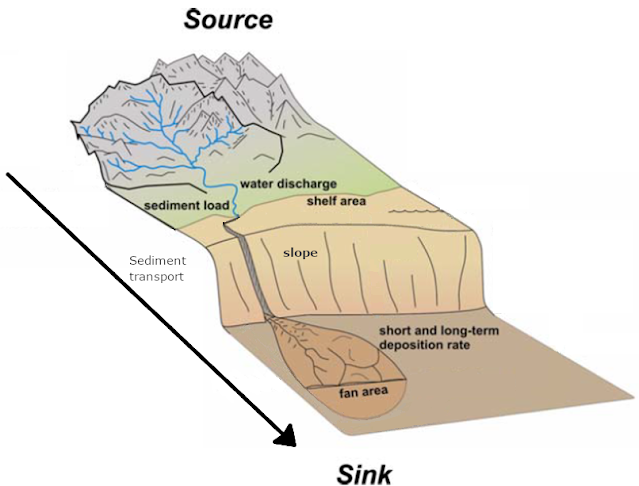ITN opportunities: Summer-schools (Part 2)
Inside Africa: Fossil source-to-sink systems, the diamond case and an eolian story, Namibia, 2023
In May 2023, from the 06th to the 20th, we travelled 3500 kms through Namibia
to follow two different source-to-sink systems: the diamond system in the South
and the aeolian system further north.
Figure 1 Bogenfels ghost town, Sperrgebiet -
Farewell at the Pink House
The story of the diamonds is both old and young and starts with the diamonds being created within Jurassic Large Igneous Provinces - fields of volcanoes that were supplied with magma from the base of very thick and old continents and therefore can contain diamonds - all over Southern Africa. The craters were then eroded, sediments deposited in a sedimentary basin, which eventually was eroded too. The transport was interrupted by multiple tectonic tilts of the South African Plateau which impacted erosion and sediment transport, while extreme climate formed thick weathering profiles and crusts and thus enriched the sediment in diamonds across tens of millions of years. Today still, diamonds are transported by the Orange River to the Atlantic Ocean, and deposited along the Namibian coastline. We stayed a few days in the Sperrgebiet to visit multiple outcrops. The Sperrgebiet is a restricted area - you can imagine how excited we were to be allowed to enter, but also how logistically challenging this trip was!
There, we met representatives of the
mining companies active in the area, namely Namdeb and Sperrgebiet Diamond
Mining. They were with us for our whole stay in the Sperrgebiet, explained how
they mine diamonds, interesting engineering practices and aspects of their
work. We didn't visit the diamond mines at the coast, but heard many stories
about how they are pushing back the ocean by building dams and then separating
the diamonds from the remaining sediment through scanners and other machines.
If you are interested, check out some satellite pictures (Diamond mines along the
Namibian coast)!
Adventurous was our camp site in the Sperrgebiet! The building is the former school for children of the miners and is nowadays used for logistics. The loo was outside behind a small wall (Fig. 2 green arrow and bottom left picture). If it wasn’t foggy you could sit there and admire buildings of the ghost town further back or listen to the sounds of the Atlantic Ocean. With no lights around you can imagine the night sky! Although you couldn’t be afraid of wild dogs, who sometimes came close while we were resting. Don't worry! They were not interested in us humans but rather looking for water and food. One can only imagine how difficult it must be to find water in this arid place, as it sometimes doesn't rain for multiple years. Only the mist from the ocean brings some humidity at night! Check how little vegetation was growing there (Fig. 2)!
Figure 2: Campsite in the Sperrgebiet with a ghost town from diamond mining in the early
20th century.
During our stay in Namibia, our local guides, who were also our drivers, chefs, and caretakers, from Matiti Safari were of great company and shared their knowledge about flora and fauna, but also about the culture and history of the country. It was a delight to learn so many societal aspects in-between our geology stops.
Throughout the field trip in Namibia, it was also visible how the group had grown together in roughly 2 years, which led to extensive scientific discussions on equal footing during the hour-long drives. Almost redundant to say how we PhD students had developed since Drangonstone, were more mature, skilled, independent, had more knowledge, and therefore were more confident. Thus stops at multiple outcrops did not want to end or had to be ended for the schedule’s/daylights sake and discussions were continued during and after dinner. One thing is certain, it is an excursion we will never forget.
Summer-schools for the future
An interesting future for the summer
schools is its future heritage: with the help of the network and participating
experts, the ITN organisers succeeded in creating 3 major checkpoints
throughout our projects. During all three years, we could see and follow our
respective projects and show it during the summer schools. When looking from Dragonstone to Inside Africa!, it is impressive to see how everyone evolved, with
discussions becoming more interesting each year. For our ITN, those
summer-schools were a success.
However, it does not end here. In the
future, Dragonstone and Inside Africa! will not only stay as a
stepping stone for our careers, but it is planned, for future generations, to
open those summer schools for other students. Our ITN members will try to make
this possible in the future, to enable students from all over the world to
experience top-science, combined with top-outcrops at an international level.
I hope that even if this post is a
little different from the previous ones, that you enjoyed it. Stay tuned for
more!




Comments
Post a Comment